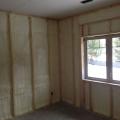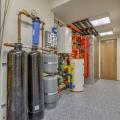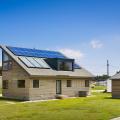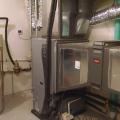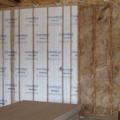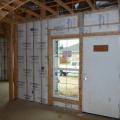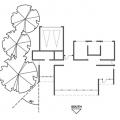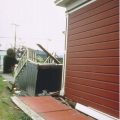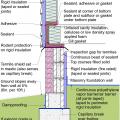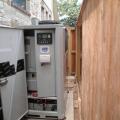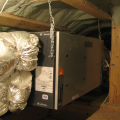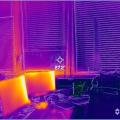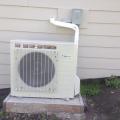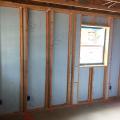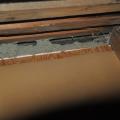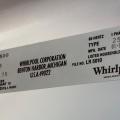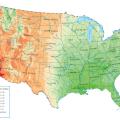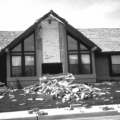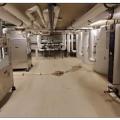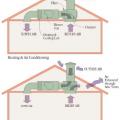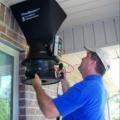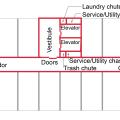Showing results 3951 - 4000 of 4973
This home was incorrectly sited and supported too near a slope consisting of unstable soils.
This home’s 2x6 advanced framed walls are insulated and air sealed with 3 inches of closed-cell spray foam.
This home’s balanced fresh air system includes a filtered fresh air intake that is wired to the central HVAC system with timer controls while exhaust fans in the kitchen, bathrooms, and laundry room pull stale and moist air from the home.
This home’s domestic hot water is provided by three systems: solar water heating panels, a heat pump water heater, and an air-to-water heat pump, which also provides hot water to a fan coil.
This home’s double-wall construction provides a 9-inch wall cavity for insulation.
This home’s double-wall structure consists of two 2x4 walls set two inches apart, then sheathed on the exterior and netted on the interior to create a 9.5-inch wall cavity that is filled with blown fiberglass insulation.
This home’s exterior walls consist of two 2x4 walls; the R-49 double wall cavity is filled with 2 inches of closed-cell spray foam plus dense-packed cellulose.
This home’s exterior walls include Larsen trusses, 9-inch I-joists attached through exterior sheathing to wall studs creating a 9-inch wall cavity that was filled with blown insulation and forms extra deep windowsills.
This home’s south-facing roof provides adequate space for both a solar electric system and solar thermal hot water system.
This home’s ultra-efficient ground-source heat pump provides hot water for space heating as well as domestic hot water for the 50-gallon storage tank.
This hot climate zone home uses high quality batt insulation between studs to insulate this connecting garage wall.
This hot climate zone home uses high quality batt insulation to insulate truss-joist headers.
This house design in the Hot-Humid climate uses a slab foundation, masonry walls, and an Exterior Insulation Finish System (EIFS) cladding.
This house is being built with advanced framing techniques including 2x6 24-inch on-center wall framing
This house is sited so the existing trees will shade the west-facing walls to minimize summertime heat gain
This house survived a wildfire due in part to fire-resistant walls and roof while surrounding houses were destroyed (Photo from Decra Roofing Systems, Used With Permission).
This house was designed with half of the basement above grade, allowing 36-inch-tall windows for egress and daylight on both sides of the house.
This house with an insulated slab is protected from pests with a termite shield at the sill plate, borate-treated framing, insect screen covering bottom of furring air gap, and brick veneer over slab-edge insulation
This house with interior insulated crawlspace is protected from pests with termite shield at sill plate, borate-treated framing, flashing at end of wall insulation, and a termite inspection gap at the top of the rigid foam
This Houston home’s unique tri-generation system combines cooling, heating, dehumidifying, hot water, and power production and storage.
This HRV, installed in a conditioned attic, provides balanced ventilation to the whole home
This infrared image shows little heat gain from north-facing double-pane windows with blinds, but significant heat output from computer monitors
This IR camera image of the ceiling shows pink and blue spots that indicate where insulation is missing in the attic.
This IR camera image reveals cold spots, likely due to air leakage at the sill plate.
This is the compact outside unit for an ultra-efficient air-to-water heat pump (COP 4.1) that provides space heating and domestic hot water.
This Kalamazoo Habitat for Humanity affiliate installs one layer of foam exterior of the studs and a second layer in between the staggered studs which are set only 2 inches apart to simplify the installation of additional fiberglass batt insulation.
This kneewall has no top plate and the resulting gap provides a wide-open pathway for air and vapor to travel between the living space and the attic
This larger, less efficient refrigerator shows a listed amperage of 6.5 A, which indicates that it draws 780 watts (6.5 A x 120 V)
This left-to-right sequence shows the method of wall extension to flood-proof a masonry house on a slab foundation. Here the new, raised floor is wood-framed over a wet-floodproofed crawlspace, but using fill to create a new raised slab is also an option.
This manometer is set up to show whole house air leakage with reference to the outside during a blower door test; the reading is showing 1,434 cfm of leakage when the home is depressurized to about 50 Pascals.
This manual dimmer switch controls the lighting output of multiple fixtures to save energy.
This map shows an annual average U.S. solar resource in kilowatt hours per day of solar energy available per square meter.
This map shows average annual precipitation across the United States, as of 2023.
This mechanical room contains both the storage tanks (right) and heat pumps (left) of a central heat pump water heating system
This metal shutter has top and bottom tracks that are permanently anchored to the wall (FEMA 577).
This MSHP operates with 120 volts power, has an EER of 18 Btu/Wh, uses about 800 W at full output, and operates remotely with a smart home control system
This multi-split heat pump system incorporates several indoor units connected to just one outdoor unit; the indoor units include a wall-mounted unit, floor-mounted, ceiling cassette, and mini-air handler.
This multistory stairwell has an automatic damper that is integrated with the engineered smoke control system.
This new filter is inserted into furnace filter slot on the return side of the furnace with the arrow on the side of the filter frame pointing in the direction of airflow, which is toward the furnace.
This night ventilation cooling system is timer-controlled and ducted to the home's HVAC ducts to bring in filtered fresh air at night.
This outdoor air intake grille provides a safe and accessible location for measuring whole-house ventilation air flow
This overhang for a south-facing window provides full shade in the summer and full sun in the winter, optimizing savings in both cooling and heating energy (results shown for 2pm in both summer and winter, 36N latitude).
This packaged central heat pump water heating system has the heat pumps on the exterior of the blue enclosure, and the storage tanks, temperature maintenance equipment, mixing valve, and control modules on the inside
This plan view shows compartmentalization of one floor of a multistory multifamily building; red lines are air barriers around vertical shafts and common areas; grey lines are air barriers between units; vestibules isolate elevators from corridors
This plastic mesh material creates an air space behind the siding and provides a route for water to run out of the wall in case of leaks.
This plot shows a heat pump’s minimum and maximum cooling capacities overlaid with a home’s cooling load line, allowing a designer to assess how well-suited the equipment is for the specific home.
This plot shows a heat pump’s minimum and maximum heating capacities overlaid with a home’s heating load line as well as the annual heating load hours for the home, allowing a designer to assess how well-suited the equipment is for the specific home.

